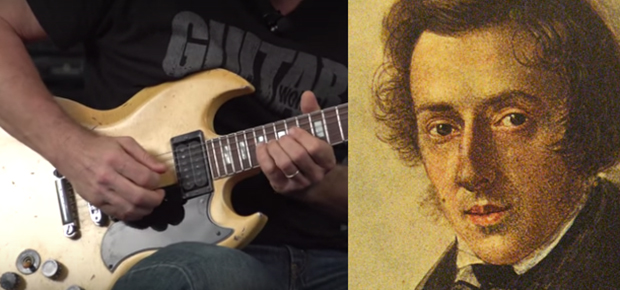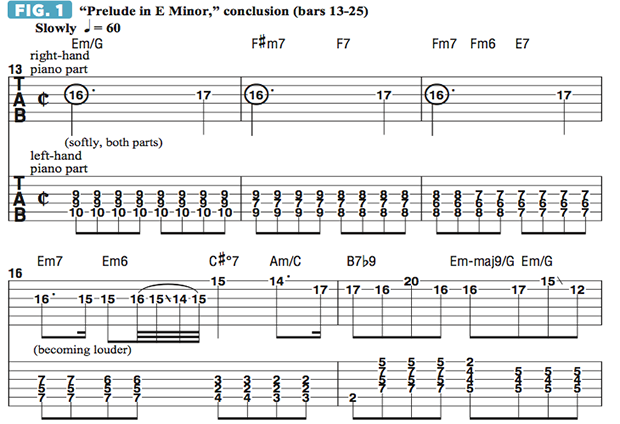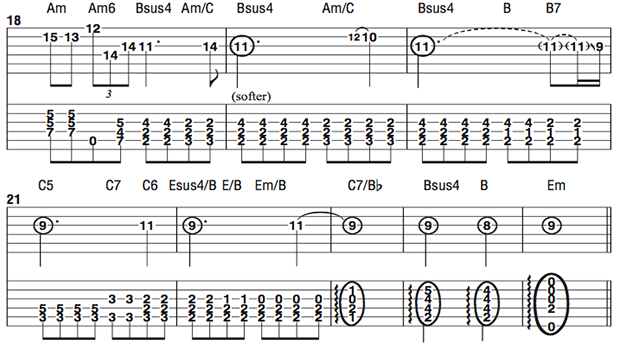String Theory with Jimmy Brown: The Conclusion of Frédéric Chopin’s “Prelude in E Minor” — Video

Last month, I presented the first half (bars 1–12) of my two-guitar arrangement of classical music great Frédéric Chopin’s piano masterpiece, “Prelude in E Minor, Opus 28, Number 4.”
I now offer the conclusion of my arrangement, which, as I stated previously, may be performed either on acoustic or electric guitars, in either case with a generous amount of hall reverb, with the accompaniment (labeled the left-hand piano part in FIGURE 1) performed fingerstyle for a pianistic, simultaneous note attack, and the melody played with a pick or fingerstyle. If playing electric guitar, a piano-like tone is best achieved by using your bridge pickup (preferably a humbucker) for both parts, with a bit of roll-off in the high frequencies.
We begin where we left off, in bar 13, with a modified restatement of the piece’s initial 12-bar theme that starts out the same way but soon veers off into new melodic and harmonic territory in bar 14, with both parts building up to a dramatic, tension-filled climax in bars 16–18, followed by a “cool down” and then a “soft landing” in the final four bars.
Again, start out using a very light touch in both parts, so that you have a greater dynamic range to work with, and feel free to add a slight, subtle vibrato to the held melody notes, which adds an expressive, vocal-like element that goes beyond what a piano can offer.
The Italian word rubato, literally meaning “robbed time,” is used in classical music to indicate a loose adherence to tempo, with a momentary slackening followed by a quickening, so as to “catch up” to the metronome.
This, combined with volume contrasts and swells (“ebb and flow”), enables the performer to put a unique, expressive stamp on his or her interpretation of a piece. In this case, I chose to gradually slow down—ritardando—for dramatic effect, beginning in bar 20. Again, you can find many examples on YouTube of world-class concert pianists performing the piece, each performance a little different.
Harmonically, the melody and chords, when heard together, imply, or “paint,” some beautifully sophisticated musical colors, such as ninth and 11th chord types. Bar 21 features what is known as a deceptive cadence, as the previous measure’s five chord, B7, resolves not to the one chord, Em, as expected, but surprisingly up a half step to C, the six chord (a slick move exploited often and popularized by Beethoven and Brahms).
To play the final four chords, you could either strum the strings with your thumb or quickly arpeggiate them with thumb and fingers in a quick rolling motion, low to high. The softer the better. The piece should end at a musical whisper.
Watch Scrolling Tabs for This Lesson!
You'll find the complete lesson video above and tabs below. However, we also offer scrolling tabs for each figure; you'll find them below.
FIGURE 1


Get The Pick Newsletter
All the latest guitar news, interviews, lessons, reviews, deals and more, direct to your inbox!
Over the past 30 years, Jimmy Brown has built a reputation as one of the world's finest music educators, through his work as a transcriber and Senior Music Editor for Guitar World magazine and Lessons Editor for its sister publication, Guitar Player. In addition to these roles, Jimmy is also a busy working musician, performing regularly in the greater New York City area. Jimmy earned a Bachelor of Music degree in Jazz Studies and Performance and Music Management from William Paterson University in 1989. He is also an experienced private guitar teacher and an accomplished writer.

